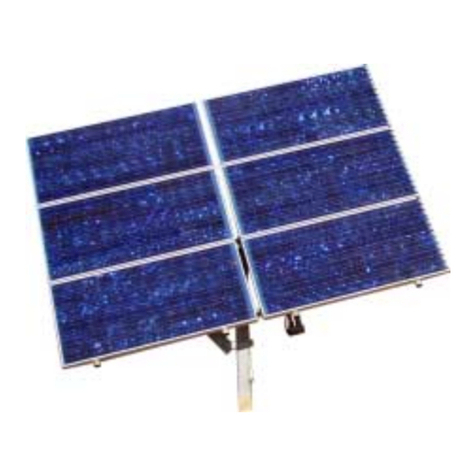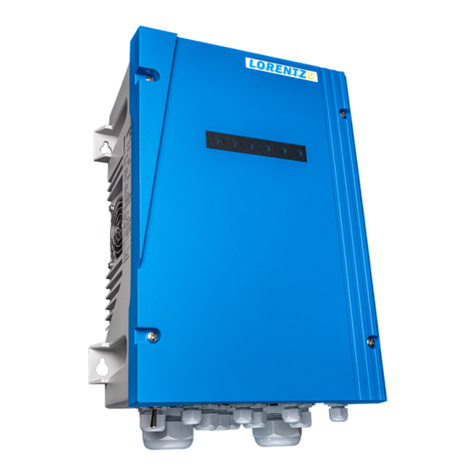The wire used to interconnect the solar modules may
be single or two conductors, from 2mm² (AWG 14) up
to 6 mm (AWG 10) gauge stranded copper wire, in a
sunlight-resistant jacket UF cable that will not degrade
when exposed to the direct sunlight. The maximum
and minimum outer diameters of the cable that may
be used with the cable connector are 8 mm and 6mm
respectively.
Route wires through the PG plugs and clamps refer to
installation example.
Gently hand-tighten the terminal screws with cross tip
(Phillips head) screwdriver. Do not over tighten to avoid
damages to the terminal.
The output wiring from the final module is generally run
to a separate array junction box. In commercial system,
this wiring from the array box to the next component
(i.e. fuse box or charge regulator etc.) is generally run in
conduit. The maximum electrical rating of an acceptable
series fuse is 6 to 12A.
After checking that module wiring is correct, close all
the junction boxes and ensure a waterproof seal.
GROUNDING
LORENTZ PV modules must only be used in configurations
with galvanic insulated inverters , that are not connected to
the grid (stand alone inverters), with the positive (+) polarity
of the PV array connected to ground protected by a fuse.
Failure to comply with this requirement will reduce the per-
formance of the system and void the Limited Power War-
ranty.
Attach all module frames to an earth ground. Attach a sepa-
rate ground wire to one of the holes marked “ground” on
the module frame with a screw and bonding or external
tooth washer. This is to ensure positive electrical contact
with the frame. The racks must also be grounded unless they
are mechanically connected by nuts and bolts to the ground-
ed modules. The array frame shall be grounded in accord-
ance with NEC Art. 250.
Positive Grounding
LORENTZ PV modules – LA series – use all-back contact
solar cells for high efficiency. This technology leads to pos-
sibly suffering from a temporary decrease in performance if
installed according to common methods without grounding
or with negative grounding. This effect is due to a surface
polarization effect caused by a small amount of leakage cur-
rent from the module. While all modules experience some
amount of leakage current, the surface polarization effect
seems to be unique to thin-film and back-contact solar cells.
If the frame of the module is on a low potential compared
to the cells voltage, the leakage current flows from the cells
through the glass to the frame. This causes a negative effect
in the cells which decreases the performance of the module.
This surface polarization effect is normally reversible by posi-
tive grounding. It usually does not cause any damage to the
module. The performance of a system that has been installed
according to common methods (without grounding or with
negative grounding) and is suffering from decreased per-
formance can normally be restored by wiring it as a positive-
grounded system.
If an off-grid AC stand alone inverter is used and the system
is positive-grounded, an isolated type must be applied. Most
standards forbid using a non-isolated (trafoless) stand alone
inverter in a system grounded on the DC side, as it can be
dangerous. There must be a real electrical separation be-
tween DC and AC.
To avoid a negative charge on the frame and thus on the
surface of the modules, the system has to be grounded on
the most positive voltage in the system, which is the positive
pole of a single module or the whole string. In every case,
ground has to be connected to the frame of the modules.
If real grounding is not possible, at least the frame has to
be connected to the most positive in the system. Basically,
ground has to be connected only at one single point to the
most positive voltage of the system. See figure 4.
Make sure to follow the local standards and codes.
For PV generators, for which positive
grounding is not possible and which
have an open circuit voltage of up to
48V DC (up to 2 pieces LAXX-12S con-
nected in series or one LAXX-24S), a positive
grounding is not required. The PV modules can be
grounded to minus.
BLOCKING DIODES
Blocking diodes are typically placed between the battery and
the PV module output to prevent battery discharge at night.
LORENTZ PV modules are made of monocrystalline cells with
high electrical “back flow” resistance to night-time battery
discharging. As a result, LORENTZ PV modules do not con-
tain a blocking diode when shipped from the factory. Most
PV charge regulators do have night-time disconnect feature,
however.
BYPASS DIODES
Partial shading of an individual module in a 12V or higher
source circuit string (i.e. two or more modules connected in
series) can cause a reverse voltage across the shaded mod-
ule. Current is then forced through the shaded area by the
other modules. When a bypass diode is wired in parallel with
the series string, the forced current will flow through the
diode and bypass the shaded module, thereby minimizing
module heating and array current losses.
Diodes that are used as bypass diodes must:
have a Rated Average Forward Current [IF(AV)] above
maximum system current at highest module operating
temperature.
have a Rated Repetitive Peak Reverse Voltage [VRRM]
above maximum system voltage at lowest module oper-
ating temperature.
BATTERY
When using the solar modules for charging batteries, the
battery must be installed in such way as ensures the per-
formance of the system and the safety of its users. Follow
the battery manufacturer’s guidelines for installation, op-
eration and maintenance recommendations. The battery (or
battery bank) should be kept from passing-by people and
animal traffic, protected from sunlight, rain, snow, debris,
and its location be well ventilated. Most batteries gener-
ate hydrogen gas when charging, which can be explosive;
in this case provide sufficient ventilation and do not light
matches or create sparks near the battery bank. For outdoor
installation, the battery should be placed in an insulated and
ventilated battery case thatis specifically designed for the
purpose.
MAINTENANCE
Inspect all PV modules annually for safe electrical connec-
tions, sound mechanical connection and freedom from cor-
rosion.
Normally the rainfall is sufficient to keep the module glass
surface clean. If dirt build-up becomes excessive, clean the
glass surface only with a soft cloth using mild detergent
and water. Remove fingerprints with standard glass cleaner.
Do not use harsh cleaning materials, such as scrapers, steel
wool, blades or other sharp instruments to clean the surface;
this will void the warranty.
Use caution when cleaning the back sur-
face of the module to avoid penetrating
the PVF sheet.
Modules that are mounted flat (0° tilt angle) should be
cleaned more often, as they will not ”self-clean“ as effec-
tively as modules mounted at a 15° tilt or greater.
Once a year, check the tightness of terminal screws and the
general condition of the wiring. Make sure that mounting
hardware is tight. Loose connections will result in a dam-
aged module or array.
NOTES
The electrical characteristics are indicated values of
Pmax under standard test conditions (irradiance of
1,000W/m2, AM 1.5 spectrum, and cell temperature
of 25° C).
Under certain conditions, a photovoltaic module is likely
to produce more current and/or voltage than reported
at standard test conditions. Accordingly, the values of
Isc and Voc marked on this module should be multiplied
by a factor of 1.25 when determining component volt-
age ratings, conductor ampacities, fuse sizes, and sizes
of regulators which are connected to the PV output.






















